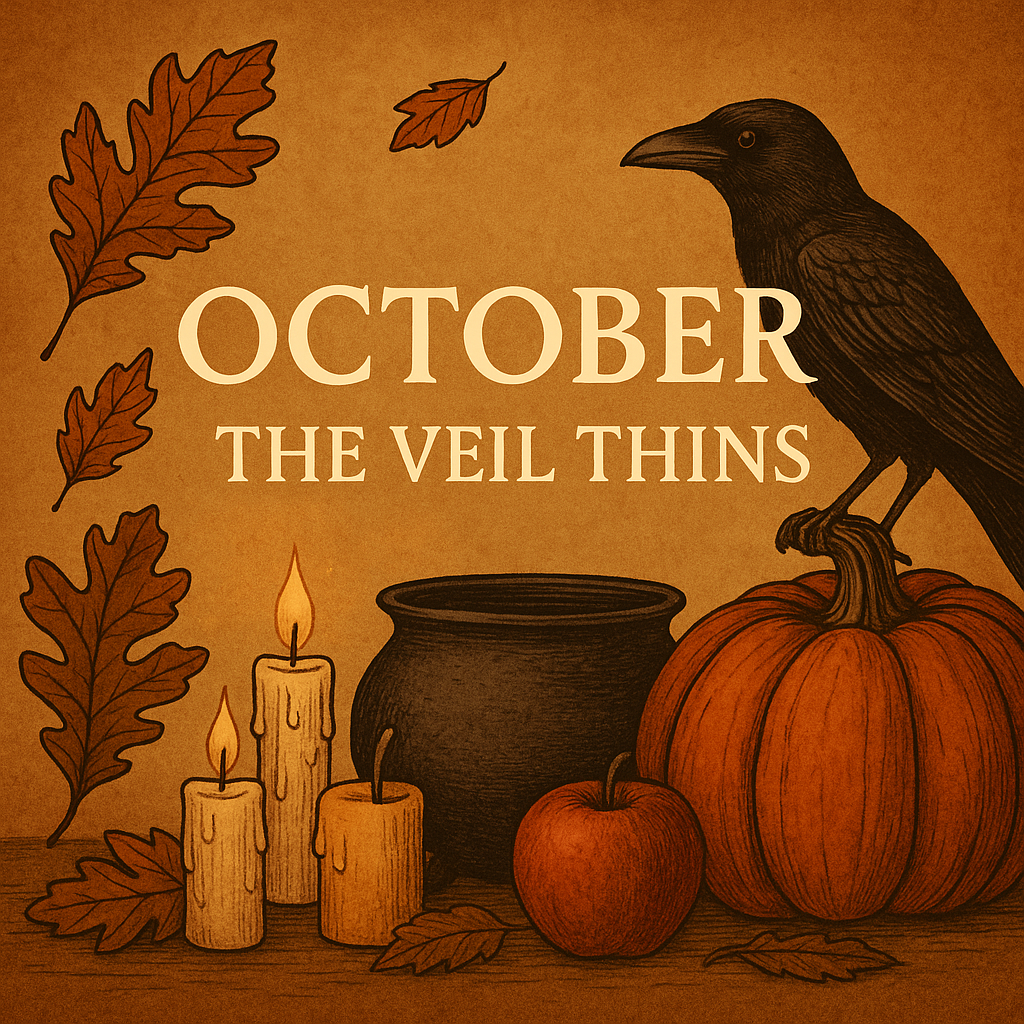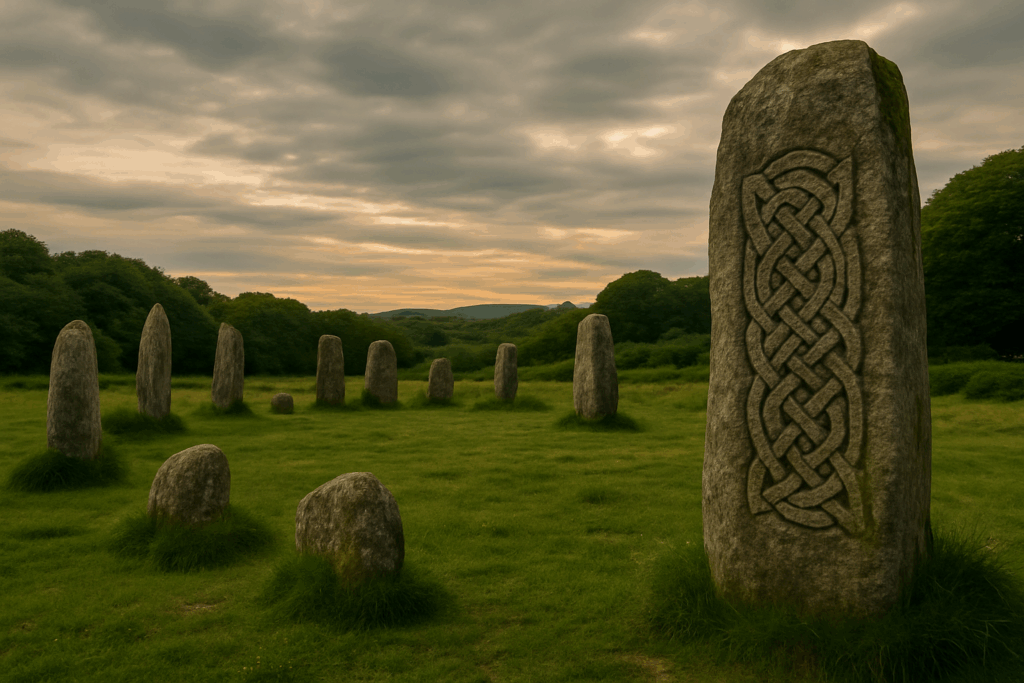October 17 – The Watcher Beneath the Moon

Night guardians, ancestral spirits, and moonlit devotion.
There is a certain kind of silence that only exists under the October moon. It isn’t the silence of emptiness, but one of awareness — as if the whole world is listening. The trees stand still. The air shimmers faintly. The light spills silver across the land, softening every edge and shadow. On such nights, you may feel the weight of unseen eyes upon you, not of menace, but of guardianship. The Watcher Beneath the Moon is awake.
For as long as humans have gazed at the moon, they have felt this presence — protective, watchful, eternal. The Watcher has no single form; it is not one deity, spirit, or ancestor. Rather, it is the collective awareness that stirs when darkness falls and the veil of night grows thin. It is the spirit that sees beyond sight, that keeps vigil over the living and the dead alike. When the moon is high in mid-October, it is said that the veil’s thinning allows the Watcher to draw near, its gaze a reminder that we are never truly alone in the dark.
In many traditions, the moon itself was considered a watcher. The Greeks saw Selene, driving her chariot across the heavens. The Romans named her Luna. The Celts honored Cerridwen, keeper of the cauldron of inspiration, her pale face mirrored in the waxing and waning orb above. For witches and mystics, the moon was the eye of the Goddess — both mirror and lamp, reflection and revelation. Beneath her gaze, truth cannot hide.
The moon’s light, though soft, is uncompromising. It illuminates what the sun cannot — the hidden parts of ourselves, the dreams we bury, the desires we fear. This is why moonlight has long been used for magical work. It is a clarifier, a purifier, and an awakener. It reveals what has been forgotten or denied, washing away illusion until only essence remains. The Watcher beneath the moon is that same force — awareness that asks nothing but honesty. When you feel watched beneath the night sky, it is your own soul returning your gaze through the mirror of light.
October’s moon carries a special energy. It is colder, clearer, tinged with melancholy. Its glow spills through thinning branches and settles on the mist like milk. This moon belongs to the ancestors. Its light is the bridge between worlds, a silver thread linking the living to the departed. It is said that under this moon, spirits gather more freely, drawn to its brightness as moths to flame. The Watcher stands at the threshold, ensuring balance, guarding both sides from crossing unbidden. To stand beneath this moon is to stand in the company of memory.
If you wish to connect with this energy, step outside tonight when the moon rises. You need no ritual tools — only awareness. Breathe deeply and let the cool air fill your lungs. Look up at the moon and allow your eyes to soften. Do not strain to see; let the light come to you. Feel it touch your skin. That faint shimmer is more than reflection; it is communion. Whisper your name into the night and listen. You may hear nothing but the rustle of leaves, yet beneath that sound lies the hum of eternity. You are being seen, not as a body, but as a spirit among spirits.
To honor the Watcher, you might light a candle or small lantern, placing it where the moonlight can touch it. This act symbolizes alignment — the human flame acknowledging the celestial one. You can say quietly, “Watcher of the Moon, Keeper of the Night, guide my steps in shadow and light.” Sit in silence afterward. Pay attention to sensations: a cool breath of wind, a sudden stirring of emotion, the sense that someone stands just beyond sight. These are signs that your offering has been received.
Some people experience the Watcher as a particular form — a figure glimpsed at the edge of dreams or a shape felt rather than seen in the dark. Others sense only presence. The form is not important. What matters is the recognition that there is awareness in the night, a consciousness interwoven with your own. The Watcher does not demand worship. It asks for respect, for mindfulness, for trust in the unseen rhythm of things.
In folklore, the moon’s light was said to reveal spirits wandering between realms. Travelers used to hang silver charms or polished mirrors by their doors to reflect the moonlight inward, believing it would keep watch over the home. In parts of Eastern Europe, people left milk or bread outside on bright nights as gifts to the “Night Mother” and her children — spirits of the departed traveling under the moon’s glow. You might adapt this practice: place a small bowl of water or milk on your windowsill as an offering to the Watcher and to the ancestors who walk in its light. In the morning, pour it onto the earth with a word of thanks.
The Watcher is not only an external guardian; it is also the watcher within — the part of you that observes your thoughts and actions with quiet compassion. Just as the moon reflects the sun’s light, so this inner witness reflects the soul’s light into the mind’s darkness. When you cultivate stillness under the moon, you awaken that inner watcher. You begin to see your life with clarity, without judgment. You recognize patterns, shadows, and truths that daylight’s distractions conceal. This practice transforms fear into awareness, and awareness into wisdom.
On moonlit nights, witches and mystics often perform rites of devotion — not for gain, but for alignment. You may try something similar. Sit beneath the moon with a bowl of water before you, the surface reflecting her face. Gaze into the reflection and whisper: “Show me what I must see.” Let images, feelings, or thoughts arise without resistance. The moon will not shout; she will whisper. Her messages come in impressions, in dreams, in subtle knowing. When finished, thank her and pour the water into the soil, returning reflection to earth.
The Watcher beneath the moon reminds us that protection does not always mean shielding. Sometimes it means illumination — casting light where fear once lived so that nothing can hide in distortion. When the moonlight touches your home, your skin, or the trees outside, it is as if the world is being gently blessed, reminded of its connection to something vast and eternal. The ancestors stir in that light, remembering their own nights beneath the same sky. Time folds; presence deepens. The living and the dead breathe together for a moment in shared stillness.
Tonight, if you wake in the small hours and see moonlight spilling through your window, do not turn away. Watch it. Feel its pulse on your face. That pale glow has traveled across eternity to touch you — it is both ancient and immediate, both the gaze of the Watcher and the reflection of your own inner awareness. In that light, everything is sacred.
May the Watcher beneath the moon keep your dreams gentle and your spirit steadfast. May your nights be filled with protection and your path with clarity. And when you stand once more beneath her glow, may you remember that you are seen, guided, and profoundly loved — by the ancestors, by the earth, and by the silent gaze of the eternal sky.





